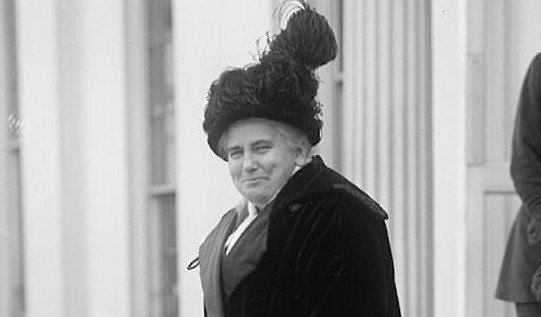by
_____
Today is Flag Day — the day we commemorate the adoption of the Stars and the Stripes by the Second Continental Congress on June 14, 1777.
It’s also a day to remember the woman’s rights speaker Anna Howard Shaw, who once found herself under attack because of her words about the American flag.
Shaw was one of the most powerful women’s suffrage leaders and speakers, with the unusual background of both a theological and a medical degree. In 1886, she began her public speaking career in support of the Temperance movement and woman’s suffrage.
In 1890, the National American Woman Suffrage Association named Shaw their national lecturer, and in 1904 she became NAWSA’s president. In addition to her strategy and organizational work, she crisscrossed the country, delivering speeches for the woman’s vote.
In many of her them, she would include this passage, to make a patriotic point about the great flag and the American values it stood for:
This is the American flag. It is a piece of bunting, and why is it that, when it is surrounded by the flags of all other nations, your eyes and mine turn first toward it and there is a warmth at our hearts such as we do not feel when we gaze on any other flag? It is not because of its artistic beauty, for other flags are as artistic. It is because you and I see in that piece of bunting what we see in no other. It is not visible to the human eye, but it is to the human soul.
In April 1917, with US involvement in World War I imminent, Shaw was named head of the Woman’s Committee of the Council of National Defense, responsible for organizing and encouraging women’s contributions to the war effort.
“This is the American flag. It is a piece of bunting. . . you and I see in that piece of bunting what we see in no other. It is not visible to the human eye, but it is to the human soul.”
Branches of women’s defense workers were created in every state, with Shaw as the driving force and the spokesperson. Women responded to the call for wartime service, taking part in food conservation, gardening farming, education, child welfare, and industry, selling Liberty Bonds, and more.
She continued to speak on behalf of women’s suffrage, but not in connection with her defense work. She kept the two separate.
Thousands heard her rousing speeches. Here’s an image of her on the speaking circuit, with an American flag in the foreground.
But not everyone approved. The anti-suffragists tried to discredit her with a smear campaign, circulating the charge that she had ridiculed and insulted the American flag. They lifted her passage out of context: “What is the American flag but a piece of bunting?”
Because she was the head of a governmental defense committee, the accusation was potentially damaging to her credibility — and the war effort.
In her own defense, Shaw released a public statement:
Everybody who knows anything about me or about woman suffragists knows very well that if I said the flag was “but a piece of bunting,” I said it in such a connection that that part of the sentence extracted from its context is worse than a deliberate falsehood. I made this statement in the presence of several members of the President’s Cabinet at a great public meeting where Senators and members of Congress were also present, and it was after this speech that I was selected by the President and the Council of National Defense as the head of the Women’s Committee. Do you think it would have been possible for them to choose me for that position if I had made any disrespectful reference to the American flag, or if in any way I had show a disloyal attitude toward the Government?
The controversy subsided — and after the war, Shaw resumed full-time traveling and lecturing for the woman’s vote.
Like so many of her fellow white suffragists, she’s an imperfect role model for today. Shaw did not hesitate to play the race card when trying to draw the critical support of Southerners to the women’s suffrage cause. It was an expedient move, an accommodation to racism that is hard to digest — a shameful part of her story, but not the whole story.
And in May 1919, she spoke at the NAACP’s National Conference on Lynching in Carnegie Hall, arguing that if women had the vote, lynching would be easier to stop.
Until the end, Shaw remained a public speaker. She was on the stump for the League to Enforce Peace when she fell ill while giving a speech in Springfield, Illinois.
She passed away in July 1919 at the age of 72, only a year before the 19th Amendment was finally adopted — realizing her lifetime dream.
© Copyright 2020
________________________________
Want to talk? Reach me at dana@danarubin.com



